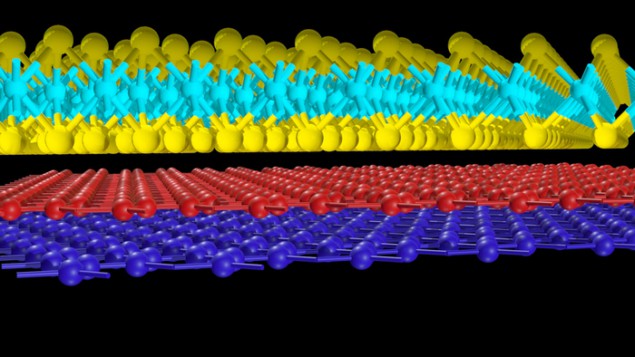Magic-angle graphene switches from superconductor to ferromagnet
04 Feb 2022 Isabelle Dumé

Magnetism and superconductivity are usually at opposite ends of the spectrum in condensed-matter physics. For them to appear in the same material is exceedingly rare. Yet that is exactly what Jia Li and colleagues at Brown University in the US found when they interfaced so-called “magic-angle” graphene with a second two-dimensional material, tungsten diselenide. Thanks to a complex interaction between the two materials, the researchers succeeded in transforming graphene from a superconductor into a powerful ferromagnet – an achievement that could give physicists a new way to study the interplay between these two usually separate phenomena.
Graphene is a 2D crystal of carbon just one atom thick. Even on its own, this “wonder material” boasts many exceptional properties, including high electrical conductivity as charge carriers (electrons and holes) zoom through the carbon lattice at very high speeds. When two such sheets are placed on top of each other with a small angle misalignment, things become even more interesting. In this configuration, the sheets form a structure known as a Moiré superlattice, and when the twist angle between them reaches 1.08°, the material begins to show properties such as superconductivity at low temperatures. At this so-called magic angle, the way in which electrons move in the two coupled sheets changes because they are now forced to organize themselves at the same energy. This leads to “flat” electronic bands, in which electron states have exactly the same energy despite having different velocities.
This flat band structure makes electrons dispersionless – that is, their kinetic energy becomes completely suppressed and they cannot move in the Moiré lattice. The result is that the particles slow almost to a halt and become localized at specific positions along the coupled sheets. This enables them to interact strongly with one another, forming the pairs that are a hallmark of superconductivity.
Not normally present in magic-angle graphene
To transform magic-angle graphene from a superconductor into a ferromagnet, the Brown University team threw a further effect into the rich mix of behaviours already exhibited by twisted bilayer magic-angle graphene. In certain materials, the spin of each electron can start to interact with the electron’s orbit around the atomic nucleus. As team member Jiang-Xiazi Lin explains, the presence of this spin-orbit coupling is associated with a wide range of quantum phenomena, but it is not normally present in magic-angle graphene. It is, however, present in tungsten diselenide. When Li, Lin and colleagues interfaced this second material with graphene, they found that strong electron correlations within the Moiré flat band in graphene allowed the material to form correlated insulating states, turning it into a ferromagnet.
The researchers’ measurements revealed that an electric current flowing in one direction across the twisted bilayer graphene sheets produces a voltage in the direction perpendicular to the current in the presence of an external magnetic field. This phenomenon is known as the Hall effect and is evidence of an intrinsic magnetic field in the material. The Brown researchers also found they could control the magnetic state of the graphene using an external magnetic field oriented either in or out of the plane of the carbon sheet. This is not possible with magnetic materials that lack spin-orbit coupling; in such materials, the intrinsic magnetism can only be controlled if the external magnetic field is aligned along the direction of the magnetism.
New experimental knob
According to team member Erin Morissette, the unique influence of spin-orbit coupling gives scientists “a new experimental knob” to turn in their efforts to understand the behaviour of magic-angle graphene. The team’s findings could also have applications in quantum computing, as the interface between a ferromagnet and a superconductor has been proposed as a potential building block for making a quantum computer. Such an interface is difficult to create precisely because magnetism is usually so destructive to superconductivity. A material capable of both ferromagnetism and superconductivity could therefore provide a way to create this interface.READ MORE

Looking ahead, the Brown scientists, who report their work in Science, say they plan to study how varying the spin-orbit coupling affects the stability of superconductivity and ferromagnetism. “This is the next step towards a better understanding of the interplay between these two phenomena in the 2D limit,” Li tells Physics World.
Want to read more?Register to unlock all the content on the site
E-MAIL ADDRESS
Register

Isabelle Dumé is a contributing editor to Physics World
FROM PHYSICSWORLD.COM 8/2/2022
Δεν υπάρχουν σχόλια:
Δημοσίευση σχολίου